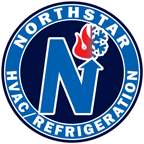Demystifying HVAC/R: 20 Common Terms Every Building Owner Should Know (Part 1)
Written by Ed Rice
Whether you're managing a large industrial refrigeration system or planning HVAC upgrades for a commercial office building, you're bound to run into technical terminology that can be confusing. That’s why we’re kicking off a multi-part series designed to break down the most common HVAC/R terms—making it easier to communicate with your service providers, make informed decisions, and understand your systems.
Welcome to Part 1 of the series, where we define 20 essential terms every building owner, facility manager, or general contractor should know.
1. HVAC
Stands for Heating, Ventilation, and Air Conditioning. It refers to the systems used to move air between indoor and outdoor areas and to heat or cool buildings.
2. Refrigerant
A chemical compound used in cooling systems (like chillers and refrigerators) that absorbs and releases heat to enable cooling. Examples include R-410A, CO₂ (R-744), and Ammonia (R-717).
3. BTU (British Thermal Unit)
A unit of energy used to measure heating and cooling capacity. One BTU is the amount of heat needed to raise the temperature of one pound of water by one degree Fahrenheit.
4. Ton of Cooling
A measurement of cooling capacity. One ton equals 12,000 BTUs per hour—roughly the cooling power needed to melt one ton of ice in 24 hours.
5. Heat Pump
A system that provides both heating and cooling by transferring heat rather than generating it. Particularly valuable for buildings looking to electrify and reduce fossil fuel usage.
6. Split System
An HVAC system with components located both inside and outside the building. Common in residential and small commercial applications.
7. Packaged Unit
An all-in-one HVAC system where heating and cooling components are housed in a single cabinet, usually mounted on a rooftop or pad.
8. RTU (Rooftop Unit)
A packaged HVAC system installed on the roof. RTUs are commonly used in commercial buildings due to their space-saving and service-accessibility advantages.
9. VRF (Variable Refrigerant Flow)
An advanced HVAC system that uses refrigerant as the cooling/heating medium and modulates its flow to individual zones for improved efficiency and comfort.
10. Chiller
A system that removes heat from a liquid via a vapor-compression or absorption cycle. That chilled fluid is then used to cool spaces or processes.
11. Compressor
The component of a refrigeration system that compresses refrigerant gas to raise its pressure and temperature so it can release heat when condensed.
12. Evaporator
The part of the system where refrigerant absorbs heat from the environment and evaporates into gas—producing a cooling effect.
13. Condenser
Where refrigerant gas releases its heat and condenses back into a liquid. Often paired with a fan and coil to reject heat to the outside air.
14. Subcooling
Occurs when liquid refrigerant is cooled below its condensation temperature. Monitoring subcooling helps ensure system efficiency and correct refrigerant charge.
15. Superheat
The temperature of a vapor above its boiling point. Used to prevent liquid refrigerant from reaching the compressor and causing damage.
16. MERV Rating (Minimum Efficiency Reporting Value)
Rates the effectiveness of air filters. The higher the number (1–16), the more particles the filter captures. Crucial for indoor air quality.
17. IAQ (Indoor Air Quality)
Refers to the quality of air within buildings, particularly as it relates to occupants' health and comfort. Affected by ventilation, filtration, humidity, and pollutant levels.
18. Preventive Maintenance (PM)
Scheduled HVAC/R maintenance designed to keep systems running efficiently, avoid breakdowns, and extend equipment life.
19. Economizer
An HVAC component that brings in outdoor air for cooling when conditions are right, reducing the need for mechanical cooling and saving energy.
20. Setpoint
The target temperature set on a thermostat or control system that HVAC equipment works to maintain.
Stay Tuned for Part 2
Next week, we’ll dive into more technical HVAC/R terminology, including energy efficiency ratings, controls, and regulatory acronyms that are shaping the future of our industry.
Need Help Navigating HVAC/R?
At Northstar Refrigeration, we don’t just install and service complex systems—we help you understand them. Whether you're planning an upgrade or simply want to improve system performance, our team is here to support your goals with expert guidance.
Call us at (508) 888-3692 or visit northstarhvacr.com to schedule a consultation.


